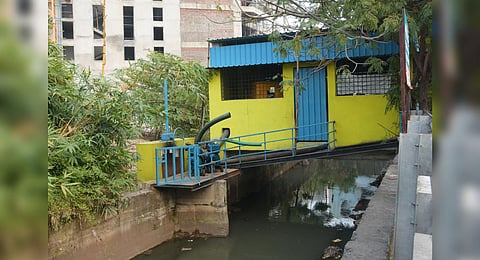

CHENNAI: Velachery and its residents have been in the news far too often than they would have liked. The area, one of the worst affected by Cyclone Michaung, remained flooded even after other parts of the city returned to normalcy.
In 2020, the city corporation constructed a permanent pump house at the disposal point at Veerangal Odai, a channel built to drain rainwater from Velachery and neighbouring areas into Pallikaranai marshland to mitigate flood damage. But when water began stagnating from the morning of December 4, corporation officials who were on the field noticed that the pump itself was submerged in the water and could not be turned on. With officials unable to turn on the pump, Veerangal Odai in full flow, high tide at disposal points, and water hyacinths clogging culverts, the area was set up for flooding.
“When I tried to go out on Monday morning, there was knee-deep water. This kept on increasing till Tuesday. When I called officials on Tuesday, they told me that the water level in VGP Selva Nagar would increase further due to surplus water being discharged from three waterbodies. Without any help till Wednesday, residents were forced to wade through above-waist-level water to get milk, food and water bottles. Some residents even used beds as makeshift boats to take sick people to safety,” said Sathyanarayanan, a resident of VGP Selva Nagar
Velachery, geographically a low-lying area, attracts run-off from Alandur, Guindy, Maduvinarai and Adambakkam. Water from the ‘Raj Bhavan’ canal, a one-km-long canal along the compound wall near Raj Bhavan colony, Nethaji road inlet, and city link road inlet drain into the Velachery Lake. From here, the course of drainage is from Pallikaranai marsh (that drains 250 sq km of South Chennai) to Okkiyam Madavu and then to the Buckingham Canal.
The area, said locals, experienced rapid urbanisation from 2005. The Velachery Lake, originally spread over 220 acres, has shrunk to 65 acres over the years. On the morning of December 4, a field-level official went to check the flow of water in the culvert near Karapakkam bridge in the area. “It was flowing fine. I went back to check around 2.30 pm, water hyacinth had clogged three of the five vents and the velocity was low,” the official said.
Apart from Saraswathy Nagar which was flooded due to a lack of retaining wall along Veerangal Odai, the major areas affected include VGP Selva Nagar, AGS Colony, Srinivasa Nagar, TANSI Nagar, Ram Nagar and Vijayanagar. The outflow from the AGS Colony depends on a four-foot drain constructed around 20 years ago through private land, said officials.
“What we need is a retention wall along the Odai to prevent water from entering residential areas and the permanent pump to be elevated so that it is not flooded. We have also asked for the Veerangal Odai to be de-silted,” said Geetha Ganesh, secretary of the AGS RWA.